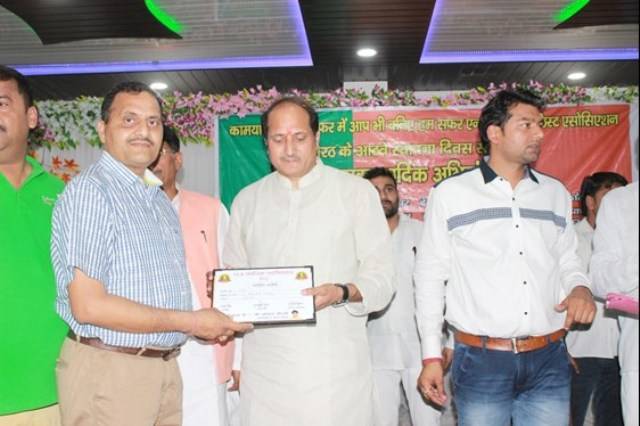
State Sugarcane Development Minister, Government of Uttar Pradesh, Shri Suresh Rana gave the best Scientist Award in the area of Sugarcane Development to Dr R S Sengar, Associate Professor for College of Biotechnology Sardar Vallabhbhai Patel University of Agriculture and Technology,Modipuram, UP
Cultivation of sugarcane in India dates back to the Vedic period. The earliest mention of sugarcane cultivation is found in Indian writings of the period 1400 to 1000 B.C. It is now widely accepted that India is the original home of Saccharum species. Saccharum barberi and Polynesian group of island especially New Guinea is the centre of origin of S. officinarum. It belongs to family Gramineae (Poaceae), class monocotyledons and order glumaceae sub family panicoidae, tribe Andripogoneae and sub tribe saccharininea. The cultivated canes belong to two main groups: (a) thin, hardy north Indian types S.barberi and S.Sinense and (b) thick, juicy noble canes Saccharum officinarum. Highly prized cane is S. officinarum.
Importance of Sugarcane: In agriculture sector, sugarcane shared is about 7% of the total value of agriculture out put and occupied about 2.6 percent of India’s gross cropped area during 2006-07. Sugarcane provides raw material for the second largest agro-based industry after textile. About 527 working sugar factories with total installed annual sugar production capacity of about 242 lakh tonnes are located in the country during 2010-11. Scientific name of Sugarcane: The genus Saccharum has five important species viz., 1. Saccharum officinarum, 2. S. Sinense, 3. S.barberi, 4. S.robustum, 5. S.spontanuem. The first three species are the cultivated species and the last two are wild ones. S. officinarum species is widely cultivated in India because of high sucrose content. Morphology of Sugarcane: Sugarcane is a tall perennial plant growing erect even up to 5 or 6 metres and produce multiple stems. The plant is composed of four principal parts, root system, stalk, leaves and inflorescence.

Cultivation of sugarcane in India dates back to the Vedic period. The earliest mention of sugarcane cultivation is found in Indian writings of the period 1400 to 1000 B.C. It is now widely accepted that India is the original home of Saccharum species. Saccharum barberi and Polynesian group of island especially New Guinea is the centre of origin of S. officinarum. It belongs to family Gramineae (Poaceae), class monocotyledons and order glumaceae sub family panicoidae, tribe Andripogoneae and sub tribe saccharininea. The cultivated canes belong to two main groups: (a) thin, hardy north Indian types S.barberi and S.Sinense and (b) thick, juicy noble canes Saccharum officinarum. Highly prized cane is S. officinarum.
Importance of Sugarcane: In agriculture sector, sugarcane shared is about 7% of the total value of agriculture out put and occupied about 2.6 percent of India’s gross cropped area during 2006-07. Sugarcane provides raw material for the second largest agro-based industry after textile. About 527 working sugar factories with total installed annual sugar production capacity of about 242 lakh tonnes are located in the country during 2010-11. Scientific name of Sugarcane: The genus Saccharum has five important species viz., 1. Saccharum officinarum, 2. S. Sinense, 3. S.barberi, 4. S.robustum, 5. S.spontanuem. The first three species are the cultivated species and the last two are wild ones. S. officinarum species is widely cultivated in India because of high sucrose content. Morphology of Sugarcane: Sugarcane is a tall perennial plant growing erect even up to 5 or 6 metres and produce multiple stems. The plant is composed of four principal parts, root system, stalk, leaves and inflorescence.
As Sugarcane is the most important plant source for sugar and alcohol production and is cultivated in more than 80 countries in tropical and subtropical areas. However, environmental factors negatively influence its yield and jeopardize the prospect to meet the increasing demand for sugar, other sugarcane derived by products and bioethanol. The development of stress tolerant plants is fundamental for the maintenance and increase of crop yields. Biotechnology to Enhance Sugarcane Productivity and Stress Tolerance provides a comprehensive account of both theoretical and practical aspects of sugarcane production. It contains extensive coverage of genome mapping and molecular breeding in sugarcane and presents the status of the elucidation and improvement of plant genomes of economic interest.

Dr Sengar is an Associate Professor for College of Biotechnology Sardar Vallabhbhai Patel University of Agriculture and Technology, India.
He received a Doctoral Degree (PhD) in Plant Physiology from in the year of 1992. He did his M.Sc. in Plant science from in the 1988. He served as an Associate Professor for more than 15 years in College of Biotechnology Sardar Vallabhbhai Patel University of Agriculture and Technology, India. As an Associate Professor, he is a recipient of many awards and grants for his valuable contributions and discoveries in plant physiology. His research interests lie in Biochemistry and Tissue Culture Technique. He is the Editorial Board Member of many peer reviewed journals and his area of expertise, as a Professor credits him with many publications in national and international journals. He is committed to highest standards of excellence and it proves through his authorship of many books.















